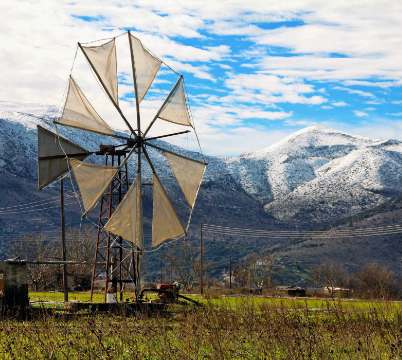Typical of the ‘80s is the image with thousands of windmills dominating the picturesque plain, surrounded by mountains, like a hand-painted oil painting inviting other artists to praise the landscape in their own way. And yet, this is an image that was praised even by Odysseas Elytis, in his artistic collage “The Message” (1968).
From the wings of Daedalus to the sails of the windmill
In Crete, the use of wind energy dates back to antiquity, when in the Minoan years the Minoans took advantage of the power of the wind on land and at sea. The great inventor and craftsman of antiquity, Daedalus, was the first to use the wind as a driving force. According to a version of mythology, this great craftsman made two individual masted ships, on which he placed sails of cloth. These ships, taking advantage of the fair wind, were faster than the rowing and slow-moving ships of Minos that pursued him. The use of sails on ships, therefore, developed the navigation of the ancient Greeks.
The inspirer and builder of the first wooden pumping windmill was Emmanouil Papadakis, the so-called “ Spirtokoutis “, who like another Daedalus invented the “vehicle” to take advantage of the wind. He came up with the idea at the age of just 20, in 1890, and was inspired by the flour mills, thus making Lasithi rich, and the whole area is indebted to him for its subsequent rural and tourist development.
It is worth noting that until then water had been pumped with the old means of pumping such as Gerani the Vinci or even with the bucket and the rope, which apart from being tedious was not fruitful, and this is why there was no growth of crops in the plain except for a few trenches near the villages for the needs of the family.
The wooden windmill becomes metal
In 1920 Stefanos Markakis (Markostefanis) made a series of innovations in the existing wooden windmill of Spirtokoutis and gained the reputation of one of the most progressive people in the Plateau. With his inventions, Markostefanis managed to modernize and perfect the mill, bringing it to its current form, replacing the wooden tower with a metal one, making it more solid, thus increasing the height of the mill, and constructed the iron bun, on which the system of the head slides in a circle.
The windpumps, with a total installed capacity of over 5 MW, were then constructed by locals, in an era and area where available materials and technologies were limited in both quantity and variety, to serve the ordinary farmer, bonding harmoniously with the environment, thus constituting an unprecedented spectacle in one of the most leeward areas of Crete.
Identical windmills in Africa and India
It is worth noting that during the period of the great drought in Africa and India in the early 1970s, the UN (Unisef) sent specialist engineers to Crete, who copied the Lasithi windmill, transferred the water pumping know-how and built identical Cretan windmills in Ethiopia, India and America.
The mills today
The mills were divided into flour mills and watermills, with the latter clearly outnumbering the former, although the flour mills clearly precede in time. After all, most farmers had other crops, which they tried to irrigate with the help of the wind – and of course, their mill.
Once, in Seli Ampelou, where the northern entrance of the Lasithi Plateau is located, there used to be 26 flour mills (seven on the right of the road and 19 on the left) facing north. All the other mills were in the plain and were watermills.
Some of them have been restored, while according to Pantelis Papadakis, President of the Cultural Association “Nostos”, today the number of mills in operation does not exceed 200, which is a disappointing number in comparison to the glorious past of Lasithi Plateau. However, we cannot ignore the fact that even today they are a pole of attraction for thousands of tourists.
George Hatzakis is the man who today constructs the sails of the windmills under restoration. The need for daily supervision of the windmill, but also the constant consistency that was required (for the farmers to open and collect the sails every day), created many problems. The technique that he developed is considered pioneering because it makes the windmills operational all year round, in all weather conditions. The use of perforated polyester cloth brought the solution. These sails have elasticity in order to withstand the intensity of the wind (the holes they have help relieve the air pressure). “Our goal is to increase the number of restored windmills to remind us of the glory that Lasithi Plateau experienced in the past,” he concluded.
